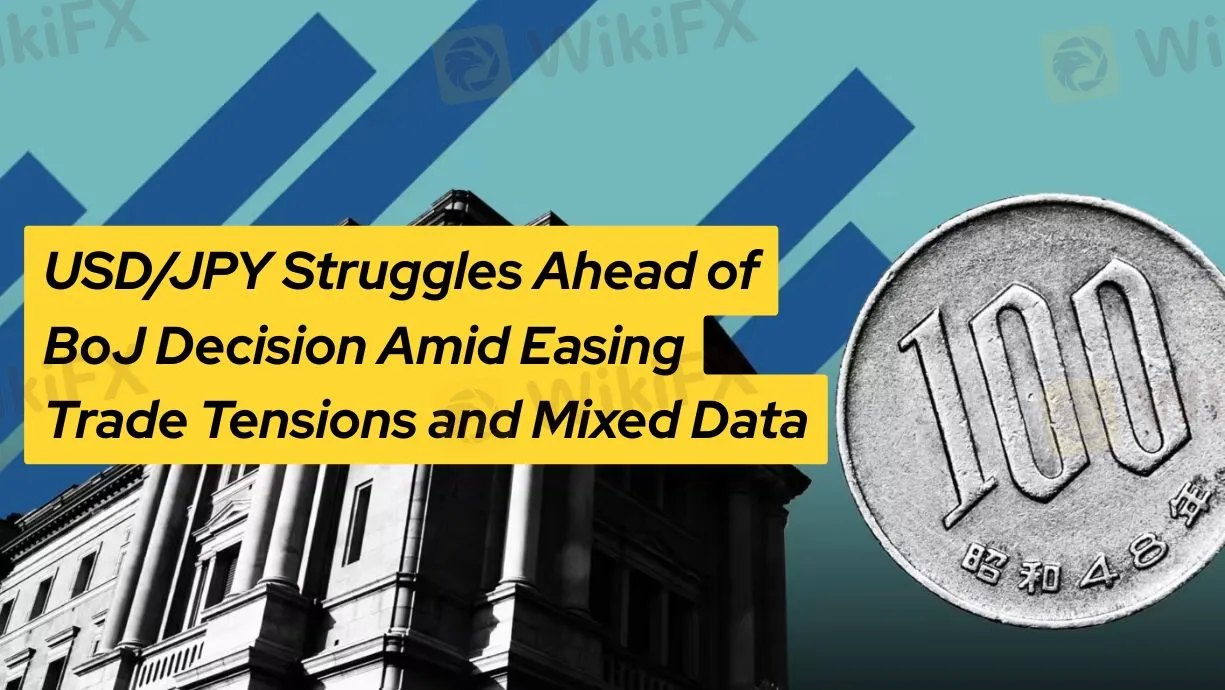简体中文
繁體中文
English
Pусский
日本語
ภาษาไทย
Tiếng Việt
Bahasa Indonesia
Español
हिन्दी
Filippiiniläinen
Français
Deutsch
Português
Türkçe
한국어
العربية
USD/JPY Struggles Ahead of BoJ Decision Amid Easing Trade Tensions and Mixed Data
Abstract:Yen pressured by weak Japanese data and improved risk sentiment; BoJ expected to hold rates steady.

As markets turn their attention to the upcoming Bank of Japan (BoJ) policy announcement, the Japanese Yen (JPY) remains under pressure, trading weaker against the US Dollar (USD) amid shifting risk sentiment and soft domestic economic data. Meanwhile, the USD/JPY pair has edged higher during the mid-week European session, bolstered by renewed USD demand and easing global trade concerns.
Easing Trade Fears Dampen Yen‘s Safe-Haven Appeal
Recent developments in the US-China trade narrative have reduced the market’s appetite for safe-haven currencies like the Yen. The White Houses latest move to grant tariff flexibility to US automakers, particularly regarding parts sourced from Canada and Mexico, has improved market sentiment. In addition, progress in multilateral trade talks has fueled optimism that protectionist headwinds may soften in the coming months.
For risk-sensitive traders, this improved outlook has lessened the urgency to hold JPY, historically favored in times of geopolitical or economic uncertainty.
Soft Japanese Data Adds to Yen Weakness
Domestically, Japan‘s economic indicators have provided little support for the Yen. Industrial production fell 1.1% in March — a sharper decline than expected — while retail sales underwhelmed with 3.1% year-on-year growth. These figures suggest that Japan’s post-pandemic recovery remains fragile, particularly as global demand fluctuates and supply chains continue to adjust.
Against this backdrop, BoJ policymakers face a difficult balancing act as they prepare to announce their latest policy stance on Thursday.
BoJ to Stay on Hold, But Inflation Keeps Tightening Option Alive
Markets largely expect the BoJ to keep rates unchanged this week, particularly given concerns over how US tariffs might weigh on Japan‘s export-dependent economy. However, Japan’s persistent inflation pressures and the wage increases granted by large firms during the year offer room for a cautious tightening path later in 2025.
This contrasts sharply with the US Federal Reserve, which is increasingly seen as tilting toward rate cuts amid weakening economic signals. Recent US data, including a sharp drop in job openings and a five-year low in consumer confidence, have intensified market expectations for Fed easing in the coming months.
Diverging Policies Set the Stage for Volatility in USD/JPY
The widening gap between BoJ and Fed policy expectations has kept the USD/JPY pair in focus. While the Dollar remains underpinned by rate-cut speculation, short-term strength has returned thanks to a rebound in treasury yields and risk-on sentiment.
Technically, the USD/JPY pair faces immediate resistance around the 142.60–142.65 level. A decisive break above this range could push the pair towards 143.40–143.45, and potentially even test the psychological 144.00 level. Conversely, sustained selling pressure below 142.00 would reinforce a bearish outlook and open the door to 141.10 and potentially sub-140.00 levels.
Outlook Hinges on Data and Central Bank Signals
With the BoJ policy announcement imminent and key US data — including the ADP jobs report and PCE inflation — due this week, traders are bracing for heightened volatility. Broader macroeconomic sentiment, central bank rhetoric, and geopolitical headlines will likely continue to shape the direction of the USD/JPY in the near term.
For now, all eyes are on the BoJ. Will it maintain its cautious stance, or could inflationary signals prompt a hawkish pivot? The answer could be critical in determining whether the Yen continues to slide — or stages a surprise comeback.
Disclaimer:
The views in this article only represent the author's personal views, and do not constitute investment advice on this platform. This platform does not guarantee the accuracy, completeness and timeliness of the information in the article, and will not be liable for any loss caused by the use of or reliance on the information in the article.
Read more

Is forex trading profitable?
Many traders think that forex trading can make quick profits, but the truth is more complex. While some people do make money in the forex market, others fall prey to its many pitfalls because, in this industry, the scams and misleading promises are widespread.

MT4 and MT5 Platforms - Helping Traders Up Their Forex Trading Game
Developed by MetaQuotes Software Corp, MetaTrader 4 and MetaTrader 5 apps come integrated with a wide range of tools that enable seamless forex investments. Learn more about their utilities.

Forex Fury Review: Is It a Scam?
Forex Fury has recently been one of the more talked-about expert advisors (EAs). Designed to work with MetaTrader 4 and MetaTrader 5, Forex Fury promotes itself as a high-performance algorithmic trading software that simplifies trading decisions and boosts profitability. It claims a 93% success rate touted by its developers.

Forex Trading Lot Size: Decide it Right to Reap the Right Results
Determining the right forex trading lot size is pivotal to enjoying a long run in the forex market. Go through this guide to know how to do it.
WikiFX Broker
Latest News
FCA clarifies expectations on bullying, harassment and violence to deepen trust in financial service
Asia-Pacific markets mixed after Trump shifts goalposts on tariffs again
XS.com Expands Global Reach with Landmark Kuwait Launch
European markets set to open mixed amid fresh U.S. tariff threats
Top Wall Street analysts are pounding the table on these 3 stocks
Stock futures fall after Trump team says tariffs will go into effect on Aug. 1: Live updates
10 Unlicensed Brokers Exposed – Check Now to Stay Safe!
S&P 500 futures fall slightly as Trump threatens new tariffs, Tesla shares drop: Live updates
Stocks are lower despite Bessent saying several trade announcements are ahead: Live updates
Exposed: Ibell Markets - A Scam Broker That Does Not Allow Withdrawals
Currency Calculator


